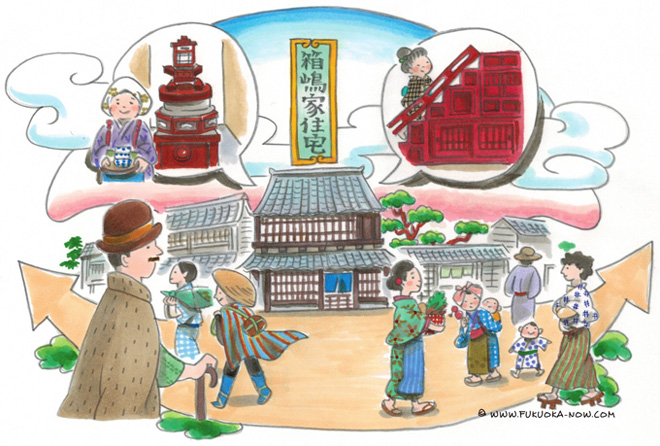Hakata Culture vol.137
Step Back in Time with a Visit to the Hakoshima Residence

The Karatsu Kaido was a spur line of the Nagasaki Kaido, an Edo era highway that connected modern-day Kitakyushu with Karatsu (Saga Prefecture) via Fukuoka City. There were five rest areas along the Karatsu Kaido that now lie within the Fukuoka City limits: Hakozaki, Hakata, Fukuoka, Meinohama and Imajuku. Remnants of the old road are few, but in Hakozaki, Higashi Ward, you can still see traditional houses and warehouses, some of which are still in use today as shops.
One of these houses, the Hakoshima Residence, is a wooden house with striking latticework that was built in 1872, just five years after the end of the Edo era. An invaluable structure that conveys what it was like to live in Japan around that time, the house has been designated by the national government as a tangible cultural property. You can tour the house, but only on weekends, and the first floor can be rented out for exhibits, musical performances and the like.
In addition to the period architecture, several other features make the Hakoshima Residence unique. First of all, it is home to a traditional oven dedicated to Kojin, the god of fire. In fact, the home used to have a second oven that was only used for celebrations and rituals. The next feature is the useful hako-kaidan, or stairs that double as a chest of drawers. Also, the red paint used inside the residence is bengara urushi, an iron-containing dark red face paint. The inner garden reveals the remnants of a suikinkutsu, or water chimes, but unfortunately due to an earthquake, they no longer make the pleasant echoing splashing sounds they are known for.
Other nearby sites also tell the history of the Karatsu Kaido. Across from Hakozaki Shrine, you can find the old stone markers that used to demarcate the boundary between the districts of Omote-kasuya-gun and Naka-gun. Carvings on the stones indicate they were erected in 1804. It is said that Hakozaki is the station on the Karatsu Kaido where travelers from Hakata and further afield used to change out of formal dress into more casual clothing to continue their journeys.
江戸時代にタイムスリップしたような箱嶋家住宅
長崎街道の脇街道として整備された唐津街道は、福岡市内を通って、現在の福岡県北九州市と佐賀県唐津市を結んでいました。江戸時代には箱崎・博多・福岡・姪浜・今宿と、5つの宿場町が市内にありました。現在は昔の街道の面影を残す場所は少ないのですが、東区の箱崎には昔ながらの伝統的な家屋や蔵が点在していて、現役の商店として活躍していたりします。
その通りの中にある箱嶋家住宅は、明治5(1872)年頃に建てられた格子が印象的な木造家屋。江戸時代末期から明治時代初期の生活様式を現在に伝える貴重な建物として、国の登録有形文化財になっています。見学を受け付けているのは週末だけですが、1階はレンタルスペースとして貸出しもしているので、展示会や音楽会などが催されていることもあります。催し物に参加したり、自分でイベントを企画することもできます。
箱嶋家住宅には、いくつかのめずらしい特徴が残っています。まず火の神様である“荒神様”を祀るかまどがあること。昔は実際に煮炊きするかまどとは別に、祭事用のかまどを設けていました。また2階への階段は機能的に造られた箱階段。さらに赤みのある屋内の塗装は、鉄分を含む赤い顔料を使った“ベンガラ漆塗り”です。中庭には水滴で音を奏でる“水琴窟”の跡もありますが、残念ながら地震で今は音がしなくなったそうです。
この箱嶋家住宅のほかにも、唐津街道の歴史を伝えるものがあります。筥崎宮の向かいにある唐津街道旧郡境石です。旧唐津街道の表糟屋郡と那珂郡の境界を表わす石碑で、石碑そのものは文化元(1804)年に造られたものと刻まれています。博多などからやってきた旅人は、箱崎宿までは正装で威厳を示し、ここで軽装に着替えて旅を続けたといわれています。

